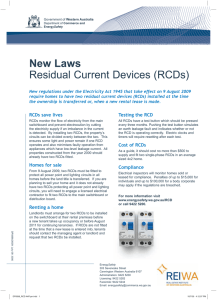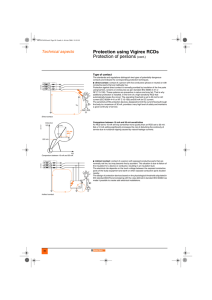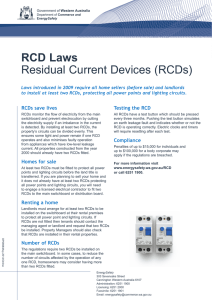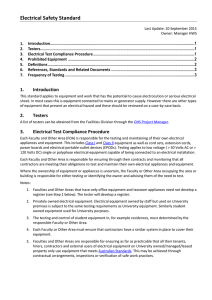TESTING OF RESIDUAL CIRCUIT DEVICES (RCDs) – B
advertisement
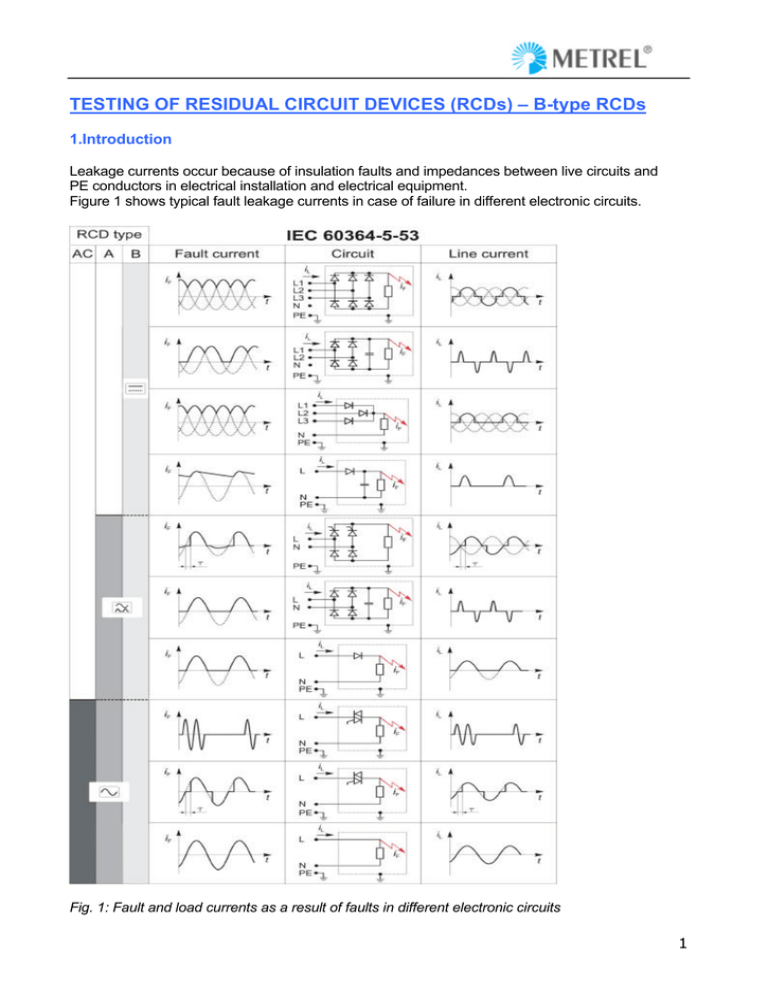
TESTING OF RESIDUAL CIRCUIT DEVICES (RCDs) – B-type RCDs 1.Introduction Leakage currents occur because of insulation faults and impedances between live circuits and PE conductors in electrical installation and electrical equipment. Figure 1 shows typical fault leakage currents in case of failure in different electronic circuits. Fig. 1: Fault and load currents as a result of faults in different electronic circuits 1 The figure shows that: • AC type RCDs protect only against AC leakage currents. • A type RCDs protect against AC and pulsating DC leakage currents. • Only type B RCDs protect electrical installation against all types of leakage currents including smooth DC leakages. Sources of DC leakage currents can be DC electrical installations, outputs from poly-phase rectifiers, large switchers or frequency converters in the equipment. In certain environments values of DC leakages can become high and dangerous, e.g.: • Construction sites: cranes, pumps, mixers • Buildings: large air-conditioners, elevators • Photovoltaic systems • Railways • Amusement parks: carrousels, trains The importance of B-type RCDs has recently increased as they provide a higher protection level than A and AC-type RCDs. For instance in Germany: • AC types are not allowed to be installed in electrical installations. • A type is the standard type. • B type is the preferred type and is obligatory in special environments. 2.Producers Some known producers of B-type RCDs are: ABB http://www.abb.de/stotz-kontakt Siemens SIQUENCE http://www.automation.siemens.com ABL_SURSUM http://www.abl-sursum.com/fehlerstromschutzschalter.html Doepke http://www.doepke.de Further information about the operation of B-type RCDs and their applications can be obtained on the above listed web sites. 3.International references Basic references for B-type RCDs are: • Technical report IEC/TR 60755:1983, General requirements for residual current operated protective devices • IEC/TR 60755-am1:1988 and IEC/TR 60755-am2:1992 Reference standards: • IEC/EN 61008-1, Residual current operated circuit-breakers without integral overcurrent protection for household and similar uses (RCCB's) • IEC/EN 61009-1, Residual current operated circuit-breakers with integral overcurrent protection for household and similar uses (RCBOs). • Draft IEC/EN 61557-6, Ed.2 Residual current devices (RCD) in TT and TN systems, Annex A. 2 4.Testing B-type RCDs The new IEC/EN 61557-6 Ed.2 includes the normative Annex A, which describes test methods for testing B-type RCDs in electrical installations. This chapter summarizes some of the most important definitions in this annex. • A B-type RCD should be verified with sinusoidal, half wave and DC test current. It must pass all tests as defined for AC, A and B types. Verification of DC current should be performed as follows: • • • • It should be verified with smooth DC current and the operating current smaller or equal to 2I ∆N. The value of the operating current is to be evaluated with a continuously increasing smooth DC current starting from 0.2I ∆N, with an increase of not more than 2I ∆N in 5 s. It should be verified with both directions of the test current. Operating uncertainty of the test current should be less than ±10 %. The defined slow increase of the residual current during the test assures that the AC component of the test current stays small enough and has too low frequency to influence the RCD operation. A suddenly applied test current is not defined (but it is defined in the IEC/TR 60755) because of its relatively large AC component. 5.Test instruments Although the testing procedures in IEC/EN 61557-6 Ed.2 are clearly defined, there are substantial differences between test equipment for testing B-type RCDs of different producers. This can lead to possible misunderstandings about test requirements and use of proper testing equipment. In this chapter the main differences are stated. Definition Some manufacturers define the A type test (with pulsed DC current) as a DC test. In certain countries this formulation is widely accepted since B-type RCDs are not used there yet. Test current value It is interesting that the test current values differ between different manufacturers although the values are clearly defined in the standards (especially in the latest IEC/EN 61557 Ed.2). Highest nominal current The highest test current available differs significantly. Since B-type RCDs are commonly used in industrial environment the test instrument should support testing RCDs with nominal values up to at least 500 mA. 3 6.METREL test instruments Tables 1 and 2 show test current values and slopes used with METREL installation testers. New METREL installation tester EurotestXA enables testing of B-type RCDs up to I∆N =500 mA. It meets the latest demands of the IEC/EN 61557-6 Ed.2 Annex A draft. Test current values for MI 3105 Metrel Measuring and Regulation Equipment Manufacturer Ljubljanska 77 SI-1354 Horjul Tel.: +386 (0)1 75 58 200 Fax: + 386 (0)1 75 49 226 E-mail: metrel@metrel.si http://www.metrel.si 4
